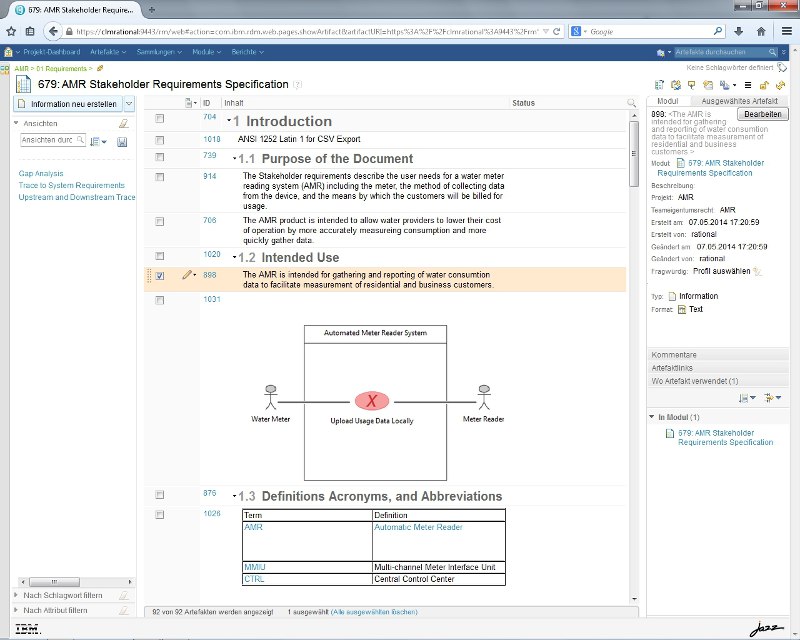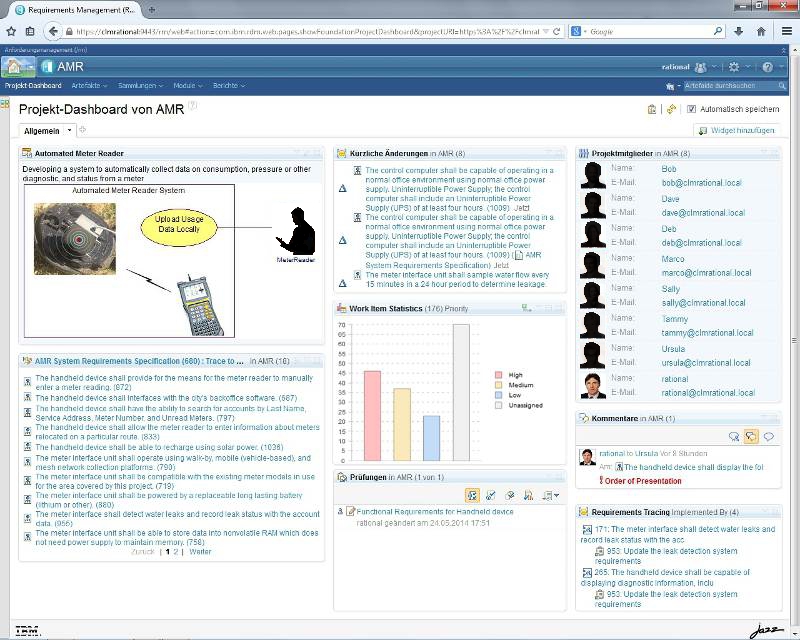DOORS Next Generation Basics
With the development of IBM DOORS Next Generation, IBM responded to the wishes of developers, project managers and IT managers a few years ago.
DNG is an AM system designed for collaboration between teams. It is web-based and uses the IBM Jazz platform. The Jazz Team Server offers an open integration architecture and collaboration through work items, dashboards, reviews and comments. The server supports the collaborative management of users and their rights, projects, data types, artifact types, attributes and keywords. Using common services and project-wide type systems, project templates and glossaries, project teams can define and manage their requirements consistently.
In lifecycle projects, administrators can manage project areas, team members and processes in all associated applications (requirements management, change and configuration management, quality management and design management). In addition, common commercial databases are supported, which provide flexible and standardized operating processes for system and project administrators. In terms of approach, IBM DOORS Next Generation is not a direct successor to IBM DOORS. The classic DOORS is still ideal for teams that need a mature, proven AM system and the corresponding professional industry functionality based on a classic full client. With regard to a smooth migration or interoperation, existing DOORS customers with active maintenance and support have the option of using DNG at no extra charge.
IT requirements
Effective collaboration and communication within a team are extremely important for product development. Many specialists and teams contribute their knowledge and need a user-friendly front end to describe, define and query requirements.
While document-based work on a specification used to be possible only with a rich client, web-based work is becoming more and more popular in many tools. This trend is also accelerating with the increased use of mobile devices in everyday work. More and more IT departments are examining the high rollout costs every time a rich client is updated on hundreds or even thousands of user clients. Since with DOORS Next the user accesses the Jazz platform with a web browser, a rich client no longer needs to be rolled out. The architecture is predestined for worldwide, decentralized access via WAN and makes a terminal server superfluous.
Clear user guidance in the tool and high-performance work are important requirements for an AM solution. DNG takes advantage of the enormous advances in web technology and allows easy and convenient work on document-oriented artifacts in the browser, including important functionalities such as drag-and-drop linking.

Defining and structuring requirements
DOORS Next Generation offers flexible ways to define and structure requirements. In a requirements project, requirements can be created as rich text artifacts and graphical artifacts. While in DOORS a requirement must always be created within a module, in DNG requirements can also be created, edited and linked individually in the project. This is particularly useful for less complex development projects.
If, however, a document-based approach is required, two different ways are available to group and manage artifacts. Collection is a group of artifacts with no specific order or hierarchy. A module is the document format known from IBM DOORS with a hierarchy of artifacts.
Use cases and user stories
When asked in the 2013 RE Compass about the techniques and notations for requirements documentation, natural language is still in the lead with around 75%, but use cases and user stories are already in second place with over 60%. DNG allows both techniques and provides an editor in the web browser for defining requirements in rich text documents and graphical representations.
The user can use business process diagrams to represent business process flows or create sketches of user interfaces that contain reusable sketch parts.
The relationship between use cases and actors can be described in use case diagrams. Also supported are storyboards in which frames are sequentially numbered and displayed on a timeline, and display flows that represent a sequence of user-controlled software processes. If the user wants to integrate models in UML and SysML, DNG offers a link to the IBM Rhapsody Model Manager, which works with IBM Rhapsody and IBM Software Architect and serves as a central design repository for development teams.
Reuse of requirements
In the area of software development, the reuse of artifacts is a common concept. In requirements management, however, it has been used less so far and copying the requirement with a link back to the original requirement has dominated.
A new product development is often based on previous development work from other projects. This applies today, among other things, to the automotive industry, where the majority of requirements for a new product line are generic. Why should requirements that are less dynamic always be created anew in a project? Simply duplicating the information and setting a link back to the original information is quick to implement and involves clear responsibility, but it can lead to error-prone manual effort as soon as the duplicate has to be synchronized with the original when changes are made.
DOORS Next Generation includes both methods and allows "copying and linking" as well as reuse in the specification module. The artifact can be reused in the project, regardless of whether it is a requirement, heading, image, model or information.
Requirements Configuration Management
As the product portfolio grows and complexity increases, it becomes increasingly difficult to keep track of everything. This is particularly the case when product lines come into play in development. How can you then ensure that the latest release of a system contains the changes from a dependent development part in addition to the generic requirements of the previous releases?
Or a product contains general functions as well as special functions tailored to the sales market. In addition to reuse, the key words here are "Requirements Configuration Management" and PLE (Product Line Engineering).
Configurations can be used to map development streams and variants by combining certain logically related artifact versions into "components". Artifact versions can be strategically reused in several configurations without copying.
In addition, component hierarchies (products) can be mapped, compared and frozen using a parent-child relationship. Change sets can be used to bundle and track changes to the artifacts.
Conflicts that may arise, such as: Parallel conflicts can be found and resolved accordingly, e.g. using compare and merge. Global configurations can be used to manage requirements data together with artifact types from other domains such as test cases, models and code. Using tools such as IBM Engineering Lifecycle Optimization - Engineering Insights, product lines can be defined, analyzed and visualized across disciplines.
Cross-disciplinary work
Another trend in requirements management is towards a holistic view of the entire life cycle of a product line. From the idea for a product to delivery, various people and teams, as well as special development tools, are involved in the process.
To ensure that the individual development phases can be completed successfully and no information is lost, complete traceability is necessary. Between the individual development phases, it is important to overcome the media breaks that can occur due to different tools and responsibilities. A project manager wants to be able to use simple means to ensure that the latest release contains all planned requirements and agreed changes.
The project status is not only limited to the requirements area, but also extends across disciplines to implementation and thus, in software projects, to the source code. It is helpful for the developer if he can use simple means to understand what the customer or client originally specified as a requirement. This is best done from his development environment, without installing additional tools or "learning" how to use them.
IBM DOORS Next Generation can provide comprehensive traceability and project metrics thanks to its close integration with change and configuration management, as well as test and design management. The project manager can easily see in the dashboard and in reports which requirements are already being implemented, how far they have already been implemented, or which requirements have been included in which release. Cross-disciplinary traceability allows an impact analysis to be carried out that determines the consequences of a change request. In DNG, the user can display the content of the linked artifact in a small window within their work area by hovering over a link with the mouse, even across discipline boundaries. To display the traceability information, the user does not have to carry out data synchronization or leave the usual work environment.
Open interfaces and expandability
While basic functionalities such as linking, drawing baselines and displaying traceability were often sufficient for AM tools in the past, today the entire process must be kept in mind. Projects must be viewed as a coherent process from the recording of customer requirements to the delivery of the system or software. At the same time, various tools are used in the overall process, which usually do not all come from the same software manufacturer and do not contain standard interfaces between the individual development disciplines. For the IT department, this means integrating various tools in the development process, connecting external service providers and at the same time establishing a reliable data exchange with suppliers.
How can artifacts along the lifecycle of an application, such as requirements, models, tasks, source code or test cases, be consistently linked and traceable? Ideally with standard interfaces and not point-to-point integrations, which are costly to maintain and quickly lead to risks as soon as the underlying operating system is updated or a new version of the interface specification is used.
Under the umbrella term Open Services for Lifecycle Collaboration (OSLC), IBM uses a lifecycle integration approach in its tools that is comparable to the hypertext concept of Internet architecture. Each resource is given a universal address that can be used to address it from any tool or other lifecycle resource. For example, users can use the OSLC integration protocol to link requirements in IBM DOORS with artifacts in DNG, thereby establishing interoperation between the two RM solutions. OSLC support is now offered not only by many IBM Engineering solutions, but also by numerous other applications.
In addition to OSLC, dashboards and various configuration options, the Client Extension Capability can be used to implement extensions such as consistency checks based on ISO 26262 ASIL via Javascript, which are among some freely available examples.
Data exchange
The communication and data exchange between different teams and between those involved in the supply chain make an important contribution to project success. The aim is to make production data available to everyone involved in a consistent manner. Requirements data between DNG and other AM tools can be exchanged bidirectionally via the implementation of ReqIF.

